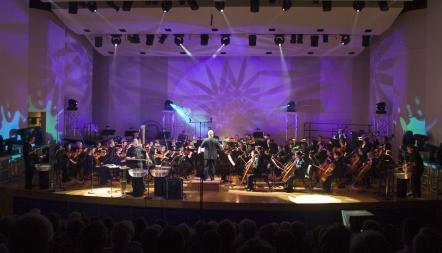New York, NY (Top40 Charts) The Kentucky Symphony Orchestra warms up a late January evening with a musical nuclear explosion. Splitting the program with highlights from John Adam's opera Dr. Atomic and Dmitri Shostakovich's revolutionary Symphony No. 11 calls upon the KSO to muster an 80-pc orchestra for a program of history, and frenetic and foreboding music.
John Adams' 2005 opera Dr. Atomic revisits the Manhattan Project and its director J. Robert Oppenheimer during the summer leading up to the 1945 test of the world's first atomic bomb in the New Mexico desert. The Dr. Atomic Symphony is based on orchestral music from the opera in three movements — "The Laboratory", "
Panic" and "Trinity," describing the days and moments prior to the bomb's detonation. Within three weeks of the test, a similar weapon leveled the city of Hiroshima, Japan. Historical images of Los Alamos and the
Trinity test will be projected above the orchestra during the performance.
Dmitri Shostakovich's Symphony No. 11 (The Year 1905) is a monumental, four-movement tone poem that describes the 'Bloody Sunday' massacre of Russians petitioning the Tsar, and the emotions surrounding the tragedy which ultimately sparked a Revolution twelve years later. Written in 1957, under politcal scrutiny to pen appropriate Soviet music, Shostakovich included popular 19th c revolutionary songs and military marches in his cinematic-styled soundscape. This rather gloomy work (compared to his boisterous 10th Symphony) coincided with the death of his wife a few years earlier. The Symphony adopted a "Socialist realist" aesthetic, which was politically popular at the time. Following the Symphony's premiere, Anna Akhmatova, one of Russia's greatest 20th c. poets, described the well-known songs that Shostakovich had incorporated — "Those songs were like white birds flying against a terrible black sky." The bloody Soviet invasion of Hungary that year together with the vivid memory of Stalin's reign of terror, suggests that Shostakovich's 11th Symphony refers to events beyond the year 1905.
"Programming works that require both musicians and the audience to bring their personal experiences, skills and knowledge to the performance, beyond the comforts and repetition of the standard classical repertoire, stretches everyone's agility, minds and ears. The KSO believes performing works written in our lifetime extends the life of classical music for future generations" —
James Cassidy, KSO
Music Director.
Bring your sunglasses and Geiger counter as the Kentucky Symphony Orchestra nukes the classics at Greaves Concert Hall in "Symphonic Fission" at 7:30 p.m., Saturday, January 25, at NKU,
Highland Heights, KY. Reserved seating tickets are $19, $27, $35 (children ages 6-18 are 50% off) and are available online at kyso.org, by phone —(859) 431-6216, or at the door.





















